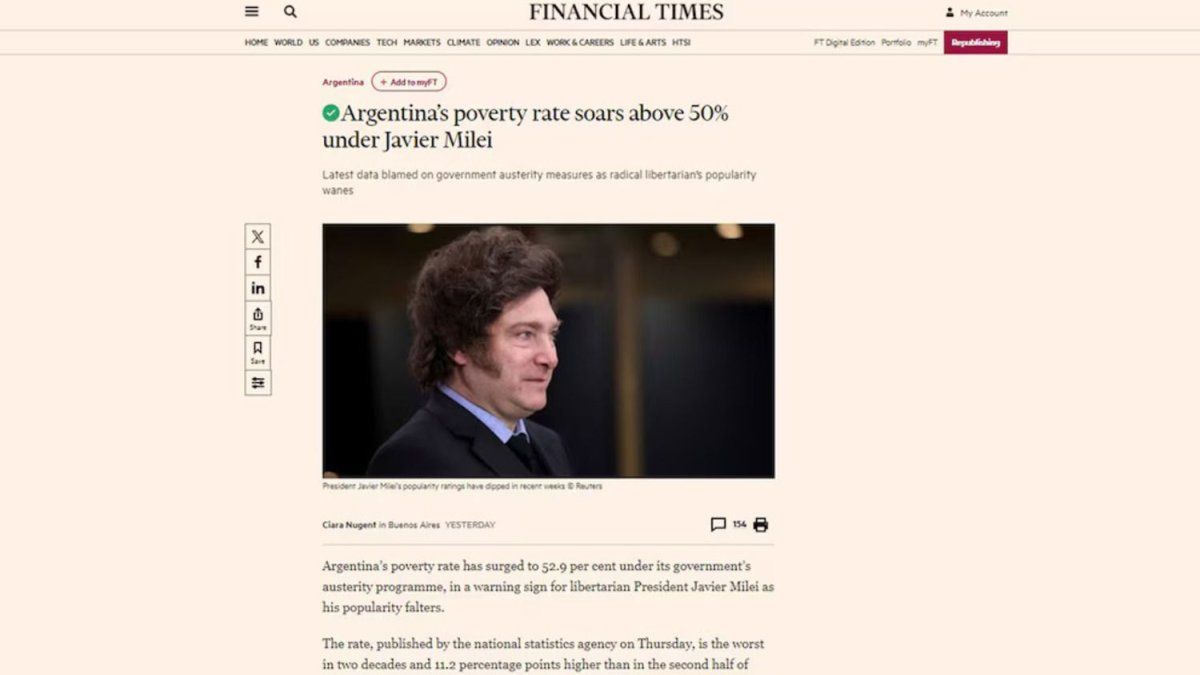The harsh poverty data, published yesterday by INDEC, generated repercussions beyond the borders of our country. In the last few hours, the Financial Times, a specialized British media, analyzed the delicate situation in Argentina and stated that the numbers are “a warning sign for libertarian President Javier Milei, as his popularity falters.
The indices known yesterday revealed that the 52.9% of the Argentine population – almost 25 million people – are in conditions of poverty, in addition to a 18% who are in a situation of destitution. The article published in the foreign newspaper highlights that this rate “is the worst in two decades and 11.2 percentage points higher than in the second half of 2023, when it stood at 41.7 percent.”
The Financial Times analysis of poverty data in Argentina
According to INDEC data, in the 9 months of Javier Milei’s management 3.4 million Argentines fell into poverty. For the mythical medium this is “a warning sign for the libertarian president” in weeks where his popularity decreased, as a result of known data and certain symbolic situations, such as the barbecue at Quinta de Olivos after the veto of the retirement reform.
Embed – https://publish.twitter.com/oembed?url=https://x.com/INDECArgentina/status/1839379446530507019&partner=&hide_thread=false
“Milei has cut public spending in an effort to reduce inflation which reached a peak close to 300 percent in April,” they highlighted in the publication, in reference to the aggressive economic plan that Milei adopted, together with Luis Caputo, the nation’s Minister of Economy. In this sense, in the Financial Times they explain that “economists say that the root cause of the high inflation is the money printed to finance the spending of previous left-wing Peronist governments”, although they also highlighted that “the elimination of price controls and a devaluation of the peso under Milei “They have also contributed” to the inflationary crisis that attacks the country.
The newspaper also noted that “l“Price increases eroded the purchasing power of workers and retirees.”
On the other hand, the article stressed that “a“At least 136,000 jobs have been lost since Milei took office and experts say the losses may be greater in the country’s large informal sector.”. However, he also recalled the 1.7% month-on-month growth in economic activity although he warned that “and“This news will only help Milei if and when the improvement is palpable to the average citizen.”
In the text, he also mentions that, along with the increase in poverty, Milei’s popularity began to decline in the polls. This is why the Financial Time analysis concludes that the challenge for the Argentine president is not only to stabilize the economy, but also to “recover the narrative that things are going in the right direction.”
The Government’s response to the poverty rate
He Ministry of Human Capital relativized the data of 52.9% poverty released by the INDEC through a statement published this Thursday. In it, the portfolio led by Sandra Pettovello stated that “visualizes a slowdown” in this index.
Embed – https://publish.twitter.com/oembed?url=https://x.com/SPettovelloOK/status/1839443846683300340?ref_src=twsrc%5Etfw%7Ctwcamp%5Etweetembed%7Ctwterm%5E1839443846683300340%7Ctwgr%5E4b46 915f8f5da486f2d141489c2e43b433336c01%7Ctwcon% 5Es1_&ref_url=https%3A%2F%2Fwww.ambito.com%2Fpolitica%2Fdespite-bad-data-poverty-the-government-affirms-that-it-sees-a-deceleration-n6064322&partner=&hide_thread=false
The data comes from the Information, Evaluation and Monitoring System of Social Programs (SIEMPRO) of the National Council for the Coordination of Social Policies, dependent on Human Capital. Poverty would have been reduced by 3.8% if the poverty index for the first quarter is compared with those for the second, published today by INDEC. In her analysis, although Pettovello admits that the poverty rate is high, the minister focuses on a slight poverty reduction and attributes this effect to the “effectiveness of the economic program that has drastically reduced inflation“.
Along these lines, the Ministry of Human Capital recalled the reinforcements made by the Government in programs aimed at children and adolescents. In fact, they highlighted that the Universal Child Allowance (AUH), the 1000 Day Plan and the Food Card, created by the governments of Cristina Kirchner and Alberto Fernández, were strengthened.
In line with his cabinet colleague, the Minister of Economy, Luis Caputoalso relativized the poverty figure and going further, warned that it “could have reached 80% or 90%”. Despite the high figure released by INDEC, “Toto” promised “a much better future for all Argentines“.
Embed – https://publish.twitter.com/oembed?url=https://x.com/LuisCaputoAR/status/1839411942399832382?ref_src=twsrc%5Etfw%7Ctwcamp%5Etweetembed%7Ctwterm%5E1839411942399832382%7Ctwgr%5E4b46 915f8f5da486f2d141489c2e43b433336c01%7Ctwcon% 5Es1_&ref_url=https%3A%2F%2Fwww.ambito.com%2Fpolitica%2Fdespite-bad-data-poverty-the-government-affirms-that-it-sees-a-deceleration-n6064322&partner=&hide_thread=false
This graph of @FernandoMarull eloquently shows the difference when the adjustment is made by the market versus a serious economic program.
From a much less critical situation, post-2001 crisis, the poverty rate almost doubled to reach 58%.
Strong evidence… https://t.co/R3KLlWabmd— totocaputo (@LuisCaputoAR) September 26, 2024
The message was shared through his official X account, where he also published a graph by economist Fernando Marull on the evolution of poverty in recent years in Argentina. “This graph by @FernandoMarull eloquently shows the difference when the adjustment is made by the market versus a serious economic program,” he explained.
“From a situation Much less critical, after the 2001 crisis, the poverty rate almost doubled to reach 58%”, he highlighted. On the other hand, according to Caputo, today the index is lower thanks to the Government’s economic program that would have made it possible to avoid an even worse catastrophe.
Source: Ambito




